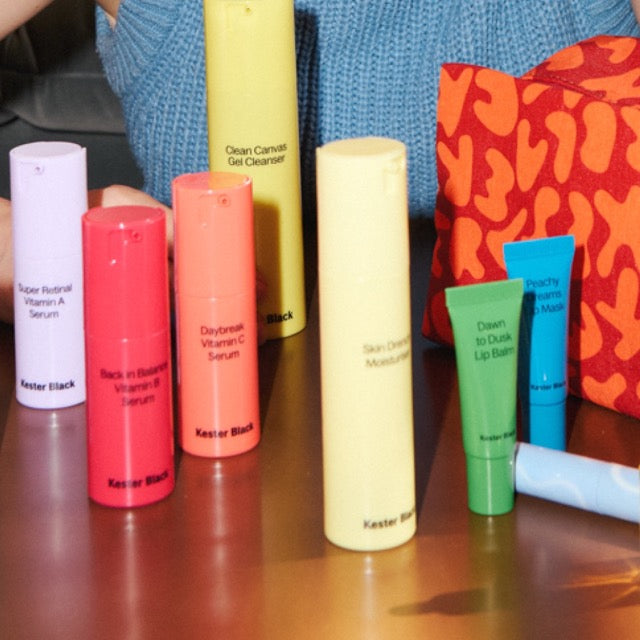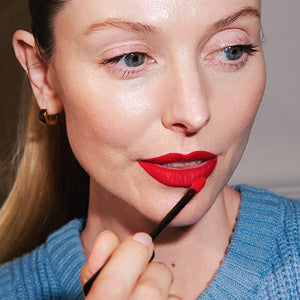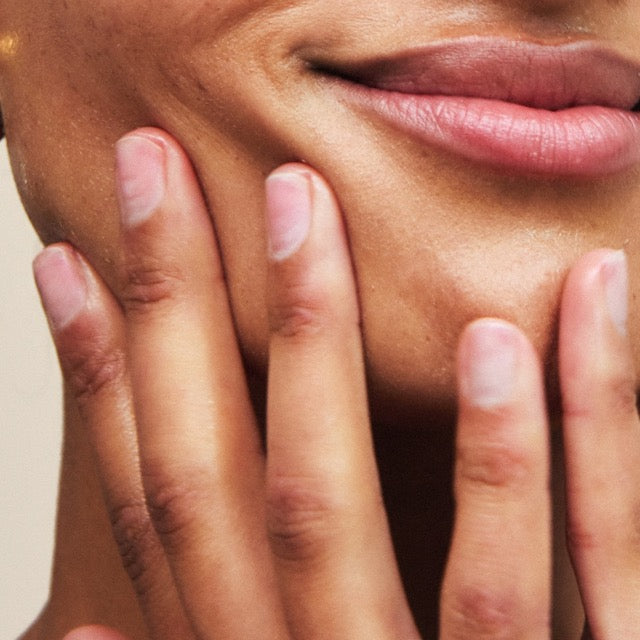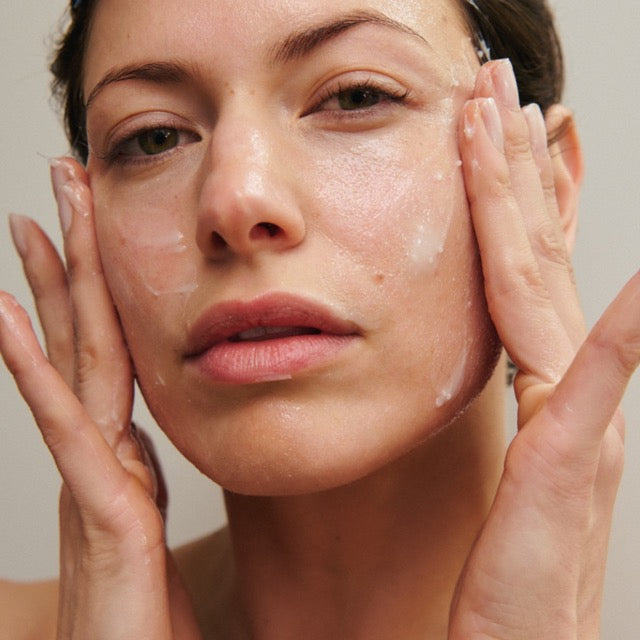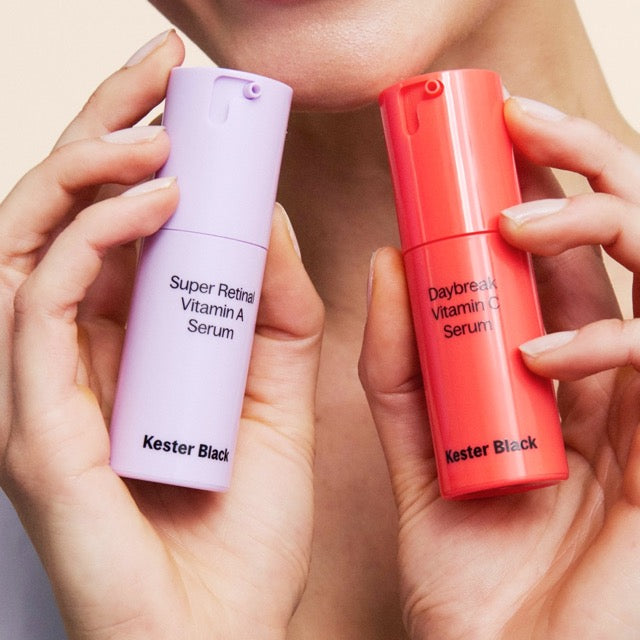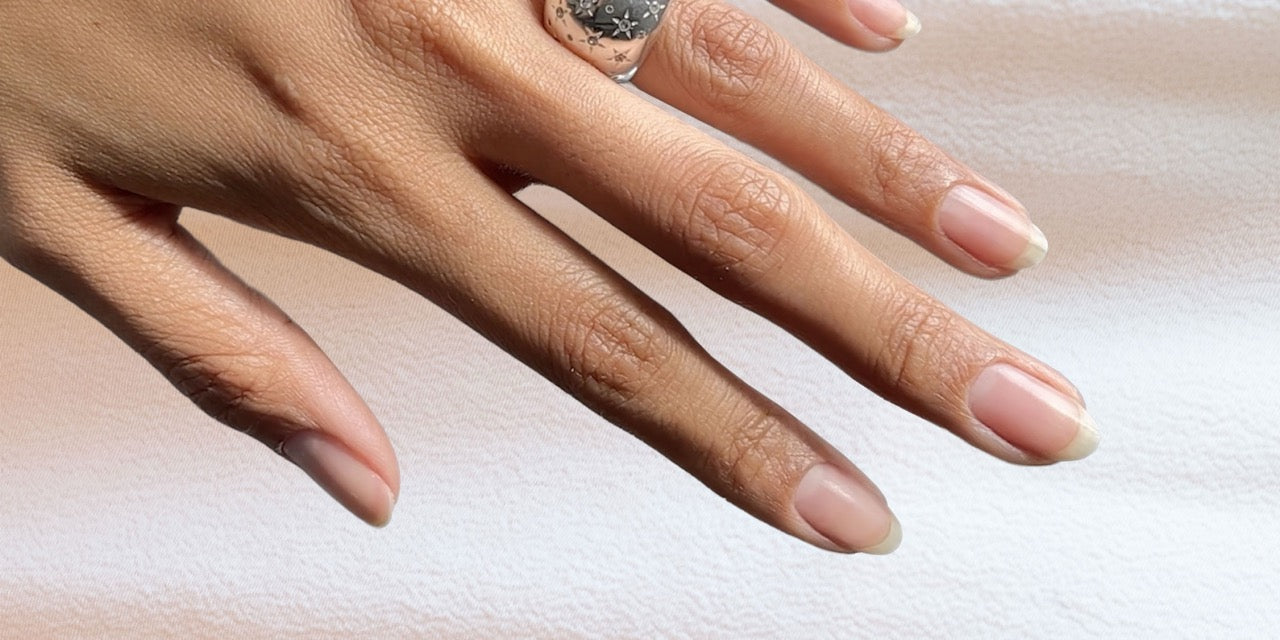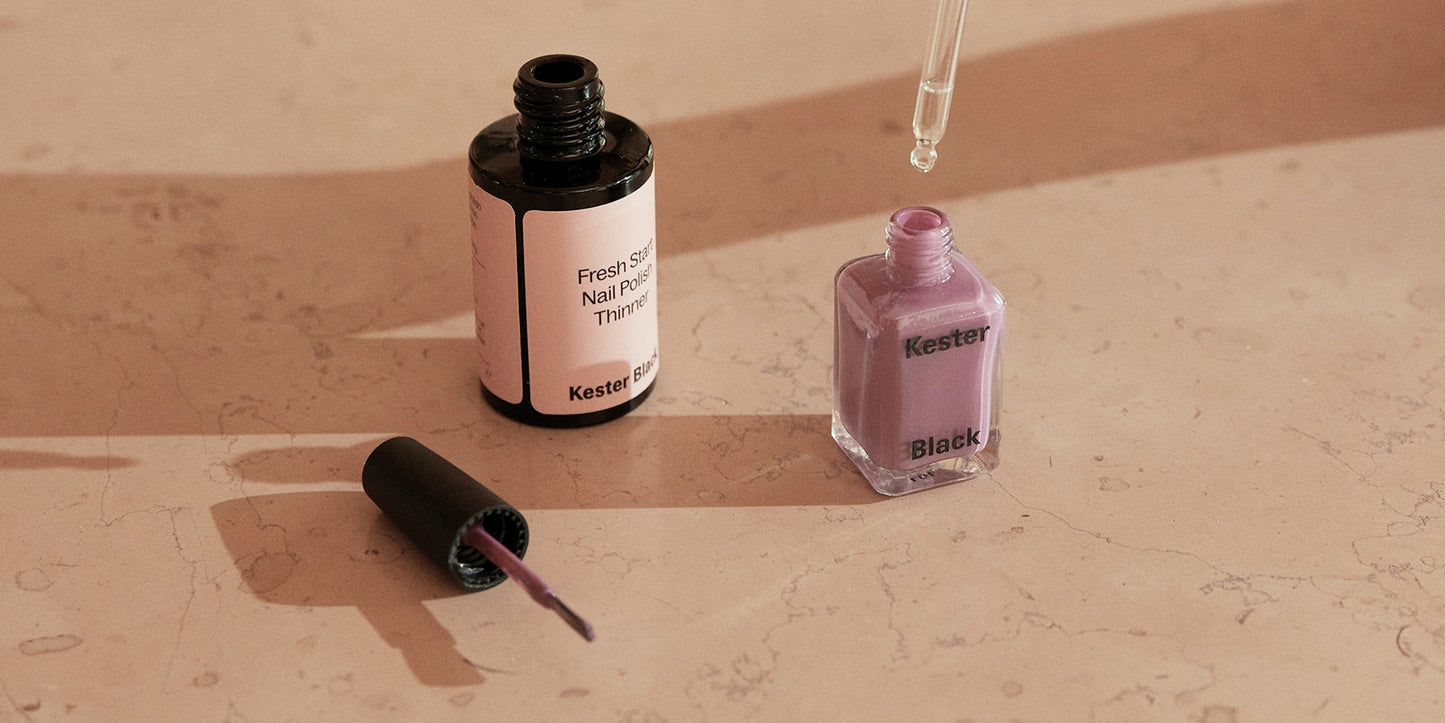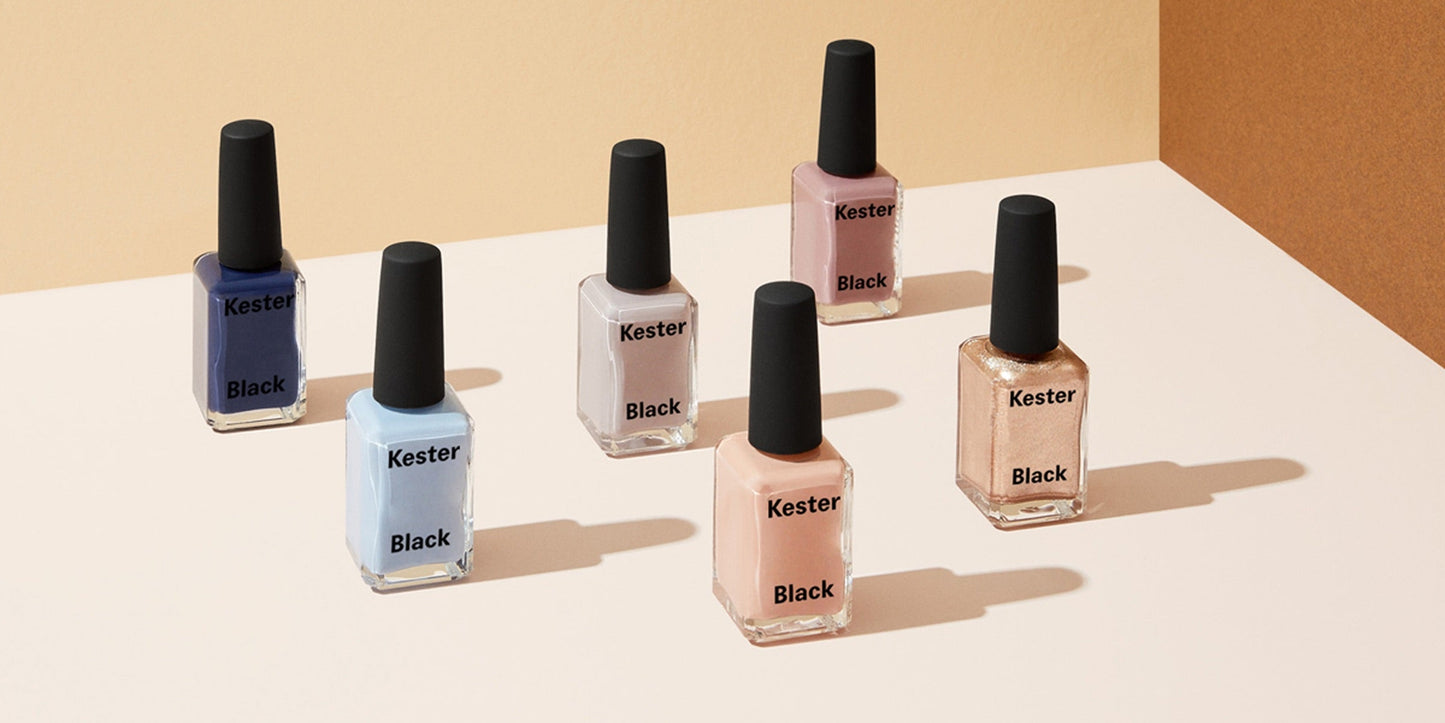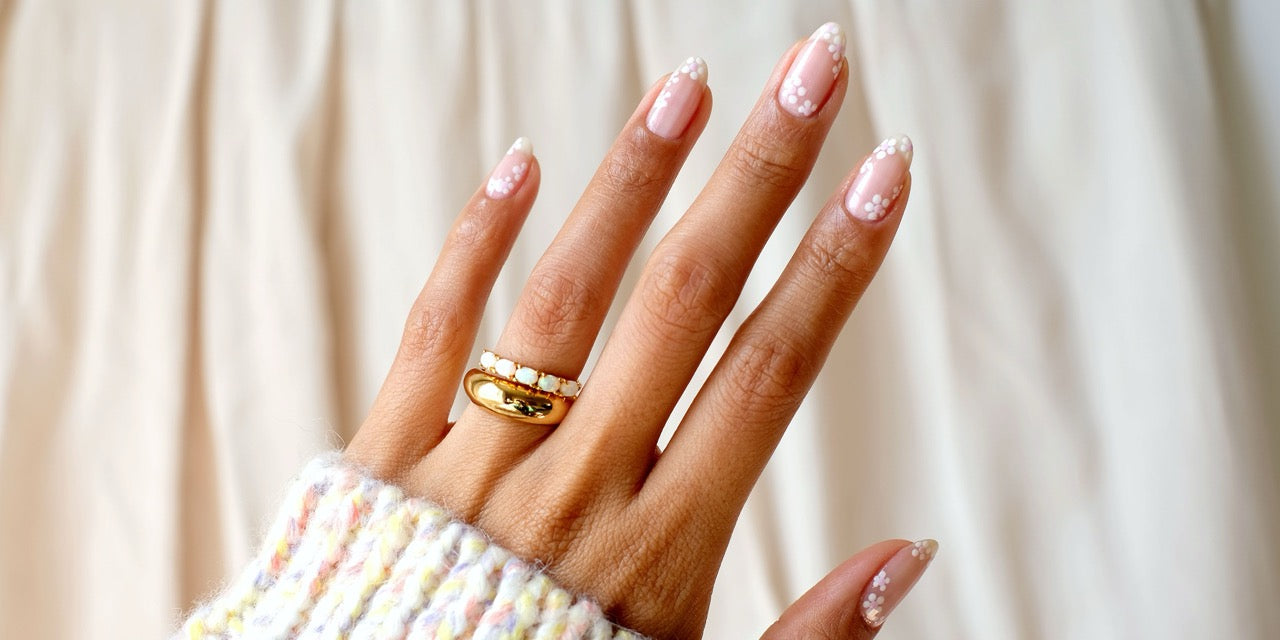Gels, acrylics, SNS and nail polish; what's the difference?
01 January 2024 – 7 min read
Ready to level up your nail game?
For some, that might mean focusing on nail health — growing strong, smooth nails with a hydrating treatment or strength system.
Others might turn to gels, acrylics or SNS. But how many of us actually understand what these nail toppings entail — or the toll they can take on natural nails?
At Kester Black, we’ve spent over a decade studying how these treatments affect nail structure and what it takes to restore long-term strength. We’ve brought it all together here in a clear, no-nonsense guide to what each involves, and how to care for your nails in between if you choose to go down any of these paths.
Standard nail polish
Humans have stained their fingertips for status as far back as 3000BC. And if it weren’t for Mary E Cobb, the first woman to introduce manicures to the masses in the late 19th century, we might still be adorning our fingers with egg whites and beeswax (not so great for the birds or the bees).
Today, nail polish is made using a film-forming polymer (like nitrocellulose) dissolved in a solvent that keeps the formula fluid. When applied to the nail, the solvent evaporates, leaving a smooth, coloured film behind. A whole series of additional ingredients can be added to improve colour, consistency and adherence.
While formulas may vary, application is pretty standard: start with a base coat to protect the nail and create a ‘primer’ layer for colour to stick to. Then multiple layers of colour are applied, followed by a clear top coat to seal and prevent chipping.
However, even with cleaner formulas and better ingredients, traditional nail polish doesn’t address the underlying causes of nail weakness or dehydration. Over time, we saw customers repair and strengthen their nails with our treatments — only to undo that progress with solvent-based nail polish and, more importantly, nail polish removers. Even the mildest removers can strip moisture from nails and surrounding skin, leaving them dry, brittle, and more prone to peeling. This realisation played a major role in our decision to discontinue coloured nail polish and focus on restorative care systems that deliver lasting results.
If you still enjoy wearing polish, protect your natural nail by applying a strengthening or hydrating base coat first — like the treatments found in our nail care sets.
Pros: Nail polish looks great on long and short nails, is easy to apply, and offers endless shades. It’s an accessible, low-commitment way to change your look.
Cons: Water, natural oils, and everyday wear affect standard polish, which only lasts between 5 to 12 days. Nail polish removers are particularly harsh, causing dehydration and damage with repeated use.
Maintenance: 2/5.
Gel nail polish
The technology behind gel nail polish has its roots in dentistry. In the 1980s, a dental supplier discovered that UV-cured polymers could also create smooth, durable nail coatings — and gel manicures were born.
In cosmetics, gel polish (or soft gel) is a semi-permanent lacquer that’s painted in layers and cured under UV or LED light. The curing process activates a polymer reaction that sandwiches two to three coats of colour between base and top coats, forming a hard, glossy, non-porous finish. This manicure can last around 2 to 3 weeks without chipping.
While gels offer durability and instant dry time, the chemical bonds that make them strong also make them difficult to remove. The process typically involves filing the nail surface and soaking in high-strength acetone — both of which dehydrate and weaken the nail plate over time. As part of our in-house testing and consumer studies, we’ve found that nail dehydration and keratin breakdown are the two biggest post-gel concerns.
If your nails feel thin or brittle after gel removal, a hydration-first repair routine is essential. Our Ultimate Nail Rescue is designed to restore the nail’s moisture barrier and flexibility in as little as two weeks, reducing the risk of long-term splitting or peeling.
Pros: Strong, glossy, and long-lasting. Ideal for locking in complex nail art.
Cons: Improper removal can damage the natural nail plate. Prolonged exposure to acetone dries the skin and nails. Gel doesn’t lengthen nails or allow them to “breathe”.
Maintenance: 3/5.
Shellac
Shellac is a brand of gel polish developed by Creative Nail Design (CND). While often marketed as gentler than traditional gel, Shellac is still a hybrid system of gel and enamel cured by UV or LED light. The application involves a base, colour, and top coat that bond together to create a hard, glossy layer.
Like all semi-permanent systems, Shellac requires careful removal and hydration afterwards. Even with modern formulas, repeated exposure to UV curing and acetone can cause nails to lose flexibility. This flexibility loss is one of the earliest signs of damage.
To restore hydration and protect the nail’s keratin structure, we recommend using the Ultimate Nail Rescue between salon treatments. Its serum-and-oil system replenishes moisture and strengthens nails without disrupting future applications. It’s also strongly recommended to regularly use a cuticle oil while you have shellac on, as it nourishes nails and cuticles to maintain nail flexibility under the shellac.
Pros: Glossy, chip-resistant finish with a lighter feel than standard gels.
Cons: Still requires curing and acetone removal; overuse can dehydrate and weaken nails.
Maintenance: 3/5.
Acrylic
Acrylic nails are made by mixing a liquid monomer and polymer powder to form a malleable dough. This is applied over the natural nail and hardens in air, forming a rigid structure. Acrylics are prized for their strength and customisable shape.
However, some older acrylic formulas contained methyl methacrylate (MMA), a compound known to cause irritation and severe nail damage. While modern salons use safer alternatives (ethyl methacrylate), the process still involves heavy filing, chemical odours, and acetone removal.
From a nail health perspective, acrylic systems create a double challenge: the hard acrylic overlay prevents natural nail movement, leading to potential tearing or delamination, while removal strips the surface layers of keratin.
If your nails feel thin or flexible after acrylic removal, begin a strengthening phase with the Strong Nails Set. It hardens weakened nails, reduces breakage, and rebuilds structure using a clinically tested treatment base coat and protective oil.
Pros: Long-lasting, durable, instantly lengthened nails, and available at most salons.
Cons: Odour, harsh chemicals, and potential over-filing. Removal is time-consuming and drying.
Maintenance: 5/5.
Gel nails, gel extensions or hard-gels
Hard gel is gel’s answer to acrylic extensions. It starts as a honey-like liquid, sculpted over a nail form, then cured to create a durable structure. The result is odourless, lightweight, and less rigid than acrylic — a benefit for both nail technicians and wearers.
While hard gels are often more comfortable than acrylics, they still require regular refills and careful removal. Filing off gel extensions can thin the natural nail, especially if performed too frequently.
We’ve observed that nails recovering from hard gels respond best to barrier-repairing formulas. The Smooth Nails Set helps smooth ridges, support hydration, and restore flexibility, helping nails grow stronger and more even after heavy salon wear.We’ve observed that nails recovering from hard gels respond best to barrier-repairing formulas. While repairing and recovering your nails after heavy salon wear, a ridge-filling base coat paired with cuticle oil can help smooth ridges, support hydration, and restore flexibility, helping nails grow stronger and more even.
Pros: Lightweight, odour-free, durable, and suitable for sculpted shapes.
Cons: High maintenance with refills every 2–3 weeks; complex removal that can weaken nails.
Maintenance: 4/5.
SNS (Signature Nail Systems)
SNS, or “dip powder” nails, use a bonding agent and coloured acrylic powder that hardens when exposed to an activating sealant. This creates a smooth, hard coating that can last up to three weeks.
Although marketed as “healthier”, dip systems still rely on glue-like resins and repeated buffing that compromise the nail’s top layers. Shared powder containers also raise hygiene concerns.
In recent years, we’ve also seen a surge in at-home dip powder kits, promising salon-quality results without the visit. However, these at-home systems don’t escape the same issues: the process is still highly technical, the removal remains complex and acetone-heavy, and incorrect application or filing can easily lead to over-thinning or tearing of the natural nail.
There’s also growing concern around microplastic exposure from dip powders and the fine dust created during filing and removal — something rarely discussed in product marketing, but worth serious consideration for both personal and environmental health.
SNS removals often involve intense filing and long acetone soaks — a combination that leaves nails dry, chalky, and brittle. Recovery from this kind of damage can take months, as nails must slowly rebuild their natural keratin structure and regain moisture balance. The dehydration caused by repeated solvent exposure affects not only the surface but also deeper layers of the nail plate, leading to peeling, splitting, and loss of flexibility. Consistent hydration, gentle care, and time are essential for restoring their natural strength and smoothness.
Pros: Long wear, fast application, strong finish, and wide colour range.
Cons: Over-filing, dehydration, potential hygiene and microplastic concerns, and complex at-home removal.
Maintenance: 4/5.
The verdict
Ultimately, the best choice depends on your lifestyle, routine and values. Salon systems such as gels, acrylics and SNS offer longevity and precision but require maintenance and recovery time.
At Kester Black, our approach is simple. Whatever you wear on your nails, the most important layer is the one underneath. Rest, repair, strengthen and smooth, then repeat.
Our nail care systems, from Ultimate Nail Rescue for deep repair to Strong Nails for rebuilding strength and Smooth Nails for refining texture, are designed to help your nails recover from salon stress and stay naturally strong in between treatments.
When you are ready to create that salon-worthy finish at home, the Flawless Nails Kit brings it all together, giving you a polished, healthy-looking manicure without UV lights, drills or harsh removers.
Because strong, healthy nails are not luck. They are care, consistency and the right formula.
